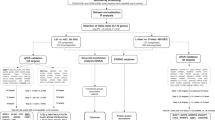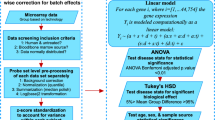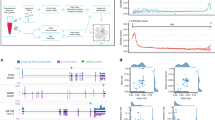Abstract
Microarrays for gene expression profiling are rapidly becoming important research tools for the identification of novel markers, for example, for novel classification of leukemias and lymphomas. Here, we review the considerations and infrastructure for microarray experiments. These considerations are illustrated via a microarray-based comparison of gene expression profiles of paired diagnosis–relapse samples from patients with precursor-B acute lymphoblastic leukemia (ALL), who relapsed during therapy or after completion of treatment. Initial experiments showed that several seemingly differentially expressed genes were actually derived from contaminating non-leukemic cells, particularly myeloid cells and T-lymphocytes. Therefore, we purified the ALL cells of the diagnosis and relapse samples if their frequency was lower than 95%. Furthermore, we observed in earlier studies that extra RNA amplification leads to skewing of particular gene transcripts. Sufficient (non-amplified) RNA of purified and paired diagnosis–relapse samples was obtained from only seven cases. The gene expression profiles were evaluated with Affymetrix U95A chips containing 12 600 human genes. These diagnosis–relapse comparisons revealed only a small number of genes (n=6) that differed significantly in expression: mostly signaling molecules and transcription factors involved in cell proliferation and cell survival were highly upregulated at relapse, but we did not observe any increase in drug-resistance markers. This finding fits with the observation that tumors with a high proliferation index have a poor prognosis. The genes that changed between diagnosis and relapse are currently not in use as diagnostic or disease progression markers, but represent potential new markers for such applications.
This is a preview of subscription content, access via your institution
Access options
Subscribe to this journal
Receive 12 print issues and online access
$259.00 per year
only $21.58 per issue
Buy this article
- Purchase on Springer Link
- Instant access to full article PDF
Prices may be subject to local taxes which are calculated during checkout







Similar content being viewed by others
References
Alizadeh AA, Eisen MB, Davis RE, Ma C, Lossos IS, Rosenwald A, Boldrick JC . Distinct types of diffuse large B-cell lymphomaQ2 identified by gene expression profiling. Nature 2000; 403: 503–511.
Armstrong SA, Staunton JE, Silverman LB, Pieters R, den Boer ML, Minden MD . MLL translocations specify a distinct gene expression profile that distinguishes a unique leukemia. Nat Genet 2002; 30: 41–47.
Davis RE, Staudt LM . Molecular diagnosis of lymphoid malignancies by gene expression profiling. Curr Opin Hematol 2002; 9: 333–338.
Ferrando AA, Neuberg DS, Staunton J, Loh ML, Huard C, Raimondi SC . Gene expression signatures define novel oncogenic pathways in T cell acute lymphoblastic leukemia. Cancer Cell 2002; 1: 75–87.
Golub TR, Slonim DK, Tamayo P, Huard C, Gaasenbeek M, Mesirov JP . Molecular classification of cancer: class discovery and class prediction by gene expression monitoring. Science 1999; 286: 531–537.
Rosenwald A, Alizadeh AA, Widhopf G, Simon R, Davis RE, Yu X . Relation of gene expression phenotype to immunoglobulin mutation genotype in B cell chronic lymphocytic leukemia. J Exp Med 2001; 194: 1639–1647.
Lipshutz RJ, Fodor SP, Gingeras TR, Lockhart DJ . High density synthetic oligonucleotide arrays. Nat Genet 1999; 21: 20–24.
Yang YH, Dudoit S, Luu P, Speed TP. Normalization for cDNA microarray data. San Jose: SPIE BiOS, 2001.
Westfall PH, Krishen A, Young SS . Using prior information to allocate significance levels for multiple endpoints. Stat Med 1998; 17: 2107–2119.
Westfall PH, Zaykin DV, Young SS . Multiple tests for genetic effects in association studies. Methods Mol Biol 2002; 184: 143–168.
Tusher VG, Tibshirani R, Chu G . Significance analysis of microarrays applied to the ionizing radiation response. Proc Natl Acad Sci USA 2001; 98: 5116–5121.
Hitoshi Y, Lorens J, Kitada SI, Fisher J, LaBarge M, Ring HZ . Toso, a cell surface, specific regulator of Fas-induced apoptosis in T cells. Immunity 1998; 8: 461–471.
Yeoh EJ, Ross ME, Shurtleff SA, Williams WK, Patel D, Mahfouz R . Classification, subtype discovery, and prediction of outcome in pediatric acute lymphoblastic leukemia by gene expression profiling. Cancer Cell 2002; 1: 133–143.
De Haas V, Verhagen OJ, von dem Borne AE, Kroes W, van den Berg H, van der Schoot CE . Quantification of minimal residual disease in children with oligoclonal B-precursor acute lymphoblastic leukemia indicates that the clones that grow out during relapse already have the slowest rate of reduction during induction therapy. Leukemia 2001; 15: 134–140.
Szczepanski T, Willemse MJ, Brinkhof B, van Wering ER, van der Burg M, van Dongen JJ . Comparative analysis of Ig and TCR gene rearrangements at diagnosis and at relapse of childhood precursor-B-ALL provides improved strategies for selection of stable PCR targets for monitoring of minimal residual disease. Blood 2002; 7: 2315–2323.
Acknowledgements
We thank members of the Molecular Immunology unit from the Department of Immunology for stimulating discussions. This work was supported in part by the Dutch Royal Society for Arts and Sciences (KNAW; FJTS), the Anna and Maurits de Cock Foundation (FJTS), the Bekales foundation (FJTS) and The Dutch Heart Foundation (CvdB).
Author information
Authors and Affiliations
Rights and permissions
About this article
Cite this article
Staal, F., van der Burg, M., Wessels, L. et al. DNA microarrays for comparison of gene expression profiles between diagnosis and relapse in precursor-B acute lymphoblastic leukemia: choice of technique and purification influence the identification of potential diagnostic markers. Leukemia 17, 1324–1332 (2003). https://doi.org/10.1038/sj.leu.2402974
Received:
Accepted:
Published:
Issue Date:
DOI: https://doi.org/10.1038/sj.leu.2402974
Keywords
This article is cited by
-
S100A8 inhibition in leukemic lymphoblasts induces sensitivity to chemotherapy and inhibition of disease relapse
Medical Oncology (2022)
-
Global expression profiling of CD10 + /CD19 + pre-B lymphoblasts from Hispanic B-ALL patients correlates with comparative TARGET database analysis
Discover Oncology (2022)
-
Childhood Acute Leukemias in Developing Nations: Successes and Challenges
Current Oncology Reports (2021)
-
Identification of critical genes to predict recurrence and death in colon cancer: integrating gene expression and bioinformatics analysis
Cancer Cell International (2018)
-
Meta-analysis of gene expression in relapsed childhood B-acute lymphoblastic leukemia
BMC Cancer (2017)



